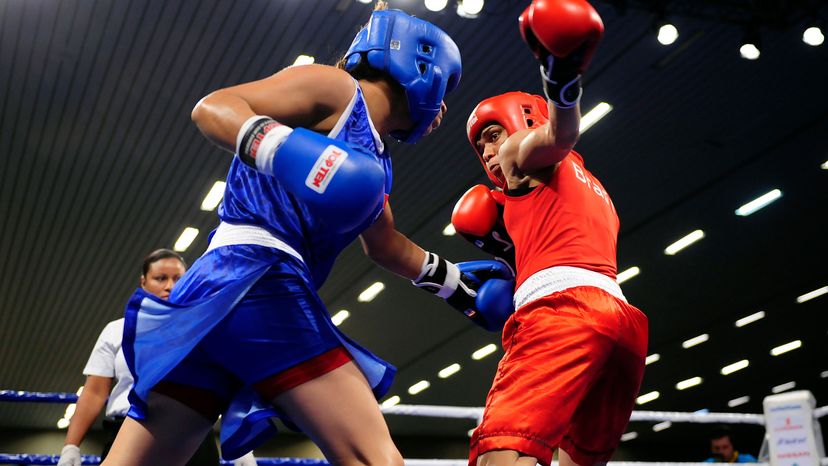
Laura's daughter Anna (both names changed) wanted to try out for her private school's lacrosse team, but she balked once she realized that the mandatory uniform included a skirt/skort.
"She did not want to wear the skirt as the uniform and felt it was too revealing and made her feel self-conscious," Laura explains in an email interview. "If the girls uniform were similar to the boys, she would have tried out." Adds her daughter, who is in the sixth grade, "Boys wear long shorts and girls have to wear short skirts and it's not fair."
Advertisement
Young Anna just had her first real-life run-in with the wild variations between what's expected of women's appearances versus men's. Many sports have traditionally featured a skirt as part of the uniform for women, in the same way that women traditionally wore mainly skirts and dresses. But you might be surprised to learn that some of the sport skirt requirements are actually very recent.
For instance, women's boxing became part of the Olympics for the first time in 2012. In 2011, the president of the AIBA, the international association representing amateur boxers, declared that the female boxers would wear skirts, because viewers had a hard time telling the difference between the male and the female boxers in competiton. After a huge outcry, the AIBA backtracked and said its athletes could wear either skirts or shorts, a policy that still exists today. A similar debate took place in the world of Olympic badminton.

"They [the governing organizations for boxing and badminton] both said out loud that they were doing it to make the women sexier and more marketable and watchable," recalls Nancy Hogshead-Makar, Olympic swimming champion, attorney and head of advocacy organization Champion Women.
She insists that the intention of the uniform is what makes the difference. "Field hockey has over a hundred years' history of wearing skirts so that's just how the sport has developed," she says, noting that female athletes shouldn't be forced to look like models simply because they're women. "If that's what you're looking for, then that's a problem because it's going to take away from the ability to look at the women's athletic accomplishments."
Jennifer Perkins, of Woodstock, Georgia, has coached lacrosse for 20 years, and played the sport in college. She describes lacrosse skirts as very comfortable and almost identical to tennis skirts and field hockey uniforms, which feature spandex shorts underneath. "I️ actually don't like when a lacrosse team wears shorts but I️ am more of a traditionalist," she says in an email. (For the record, the Federation of International Lacrosse says shorts or kilts are OK for uniforms).
Perkins isn't alone in that sentiment, either. The Women's Professional Lacrosse League (WPLL) recently consulted players about whether they prefer to play in skirts or shorts. Surprisingly, most indicated skirts as their uniform of choice, although there were strong opinions on both sides of the debate.
"I think skirts pay tribute to the tradition and gracefulness of the game as female lacrosse players have been wearing them for over a hundred years," explains Courtney Waite, player for WPLL team Philadelphia Fire. "On a practical level, skirts are comfortable to compete in, while I have found some styles of lacrosse shorts on the market today to be somewhat bulky and more constrictive. Visually, skirts are attractive and offer a visual representation of the multiple facets of female athletes. Women can celebrate their femininity, strength, and athleticism."
Fellow WPPL player Olivia Hompe, who plays for Upstate Pride, respectfully disagrees. "While I think skirts look nice and are comfortable to play in, I do think competing in skirts takes away a degree of legitimacy from women as athletes. It is unimaginable that any male professional sports would wear skirts to compete," she says in an email.
Of course, some sports are more flexible in terms of dress code, but those tend to be individual sports like women's golf or tennis. Even Wimbledon is OK with women wearing shorts — as long as they are white.

"They [women playing individual sports] can wear what's most comfortable for them," Hogshead-Makar says. "In a team sport it's harder, but there's no reason why one person couldn't wear a skirt or shorts as long as they're the same color. Just like individual sports, athletes should be able to have the choice," she says. "To have a kid not participate because they don't have a choice or are not comfortable with the dress code, that's highly problematic."
The Women's Sports Foundation has a position paper with guidelines for athletic uniforms. It notes, among other things, that uniforms should take into consideration "comfort and drag reduction," the "impact on body type and body presentation," as well as issues related to "inappropriate marketing exploitation."
Advertisement
